
Emmanuel Martinez Portfolio
The Riddle of Time
Published December 30, 2023 10 mins. read
The distinction between the past, present and future is only a stubbornly persistent illusion.- Albert Einstein
Tick. Tock.
Less than 48 hours. Two sleeps away.
It's all that stands between 2023 and 2024. People are out and about, getting ready for the big night. Families are cozying up in their homes, preparing for the "New Year" celebration. Kids are running around outside, laughing and shouting, too excited to keep still. It's like the whole world is holding its breath, waiting for the magic of a new year to begin.
But let's pause for a second. Have you ever stopped and wonder what truly passes in that blink? We, humans, hear of the word 'time', all the time, it is so conveniently "everywhere" that most people don't even bother to think about it anything beyond deadlines and schedules. But as the clocks tick and calendars relentlessly turn their pages— what is it that they actually measure?
Ever since I was a child, it is one of the questions I caught myself asking from, well, time to time. Sometimes, I would ask my parents, teachers, or even playmates about it. Some of their answers go from simple explanations related to clocks, or about the past, present, and future, to humorous answers. I would simply nod to their answers, but none of it ever really satisfied my curiousity. The mystery of time persisted. It was like an invisible force guiding our lives, yet slipping through our fingers like grains of sand.
Of course, I wasn't the first person to ask this question. Thousands of years ago, many prominent figures and cultures have also pondered the same inquiries. Ancient Egyptians, such as Ptahhotep contemplated the nature of time. He thought about how our minutes fly by. He said we have to live them wisely, 'cause once they're gone, there's no buying them back. Across the Indian civilization, they talked about time not linearly, but in loops, where everything starts and ends and starts again, way longer than any New Year's countdown we know. Meanwhile, the early Greek philosophers generally believed that the universe and time itself was infinite: no beginning and no end. In the 5th Century BCE, philosopher Antiphon said that time is not a reality, but a concept or a measure.
As human knowledge and technology progressed over centuries and millenia, our inquiries and understanding about time also evolved. In the time of Isaac Newton, which was the late 17th and early 18th century, the prominent understanding was that time was an absolute and unchanging entity. Newtonian physics, as described in Newton's Principia Mathematica, considered time to be an independent parameter that flowed uniformly, unaffected by other physical processes. It served as a constant backdrop against which the laws of motion and gravity operated. In short, a "universal clock" exists. Time is the same for everyone and everywhere in the universe. This was widely accepted, because it matches our basic human intuition. It aligns with out everyday view of reality. It was comfortable and relatively easy to understand. This classical view of time worked well for describing the motion of everyday objects and celestial bodies.
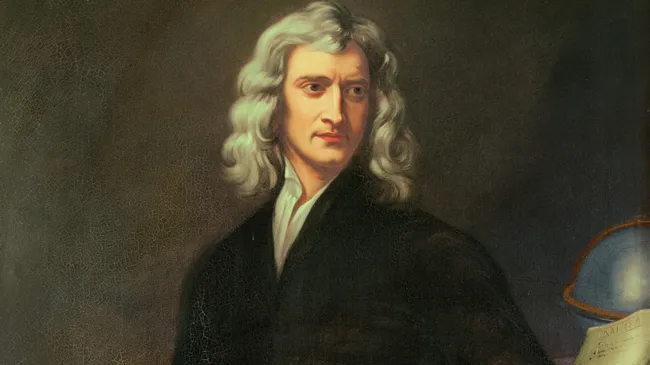
Newton viewed time as unchanging and constant everywhere in the universe.
However, this once solid view of time soon faced challenges as scientific understanding progressed and technology enabled more precise measurements. Certain phenomena, such as the behavior of light, began to defy the predictions of classical mechanics. What do I mean by this? For example, according to classical mechanics, if you're on a moving object and you shine a beam of light forward, its speed should add to the speed of the object. This expectation was based on the classical idea that space and time are absolute and unchanging. In 1887, two scientists named Michelson and Morley, conducted an experiment that sought to detect the Earth's motion through a hypothetical "ether," the medium presumed to carry light waves. According to classical physics, the speed of light should vary depending on the Earth's motion through this ether. To the surprise of Michelson and Morley, and to the confusion of the scientific community, no such interference pattern was observed. It seemed that the speed of light remained the same, regardless of the orientation of the apparatus or the Earth's motion through space.
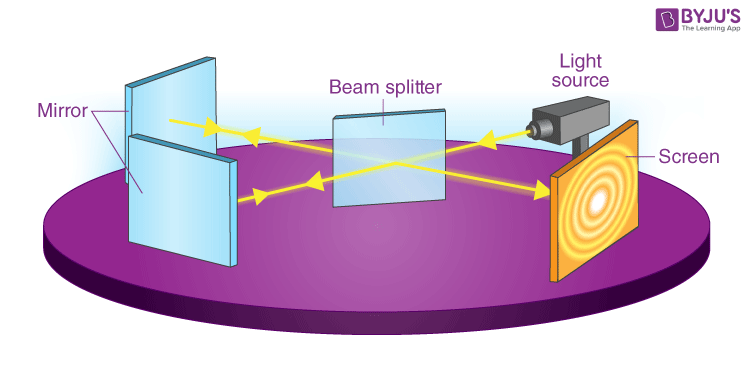
The Michelson-Morley experiment showed that the speed of light is constant regardless of the motion of the observer
Why is this a problem? Classical physics, which views space and time as constant and unchanging, predicts that the speed of light should be influenced by the motion of the observer or the source of light. However, the results of this experiment exposed the limitations of classical physics and sparked a debate among the scientific commumnity. This inconsistency about our theories about how the universe works and what is observed means that we need to re-examine and revolutionize the way we think about space and time.
It wasn't until more than a hundred years later, precisely in 1905, when Albert Einstein published a series of groundbreaking papers that would shake the foundation of classical physics and birthed the era of modern physics, that fundamentally shifted the way we view space, time, and eventually the nature of reality and the universe.
Let's talk about the first paper, Theory of Special Relativity. Imagine time as a flexible thing—it doesn't tick the same for everyone. If you're moving fast, time slows down a bit for you compared to someone sitting still. Also, if you could somehow turn mass into energy, as shown by the famous equation E=mc², you'd get a lot of energy. This theory changed how we think about time and told us that mass and energy are like two sides of the same coin.
Here is the craziest part though: you see, in classical physics, space and time were considered separate entities. However, Einstein showed us that space and time are not separate, but rather interconnected on what is called spacetime, forming a four-dimensional framework of the reality. According to this theory, an event in the universe is described not just by its spatial coordinates (three dimensions: length, width, and height) but also by its temporal coordinate (time). The theory of special relativity highlighted a new, groundbreaking truth: time and space are not absolute but are intertwined, and we we need to give up the idea that there is a "universal" time, and accept that the time registered by a clock depends on its trajectory as it moves through the universe.
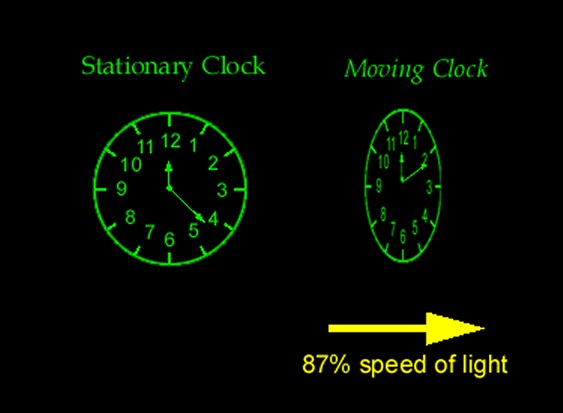
Special Relativity tells us that there is no such thing as "universal" clock. The passage of time can change relative to the observer's motion. The faster you move through space, the slower you move through time.
In 1915, building on special relativity, Einstein extended his ideas on the most ambitious theory he ever published, and perhaps one of the most important theories in physics: the General Theory of Relativity. In this theory, he challenged our understanding of one of the fundamental forces of the universe: gravity. Einstein showed that gravity is not exactly a force, but a curvature of spacetime itself. Massive objects, like planets and stars, create a curvature in the space around them, and other objects move along the curves in this distorted spacetime.
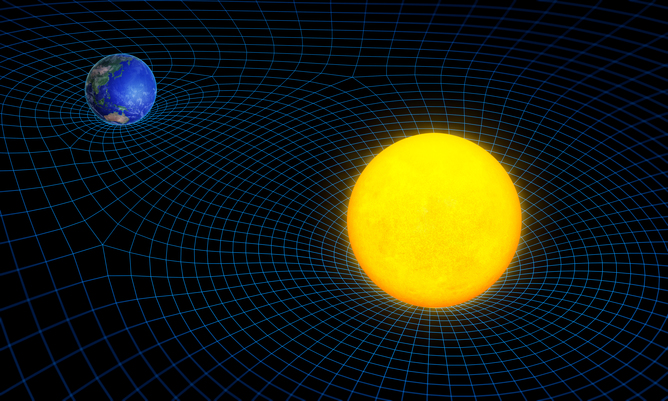
Einstein showed that gravity is a result of the bending of spacetime. Note: space and time.
Consider, for a moment, we put a clock ticking away in the vastness of space. Now, imagine placing this clock near a massive object, like a planet. According to Einstein's theory, the gravitational pull of the planet causes the spacetime fabric to curve, literally affecting the ticking of our clock and slowing it down. As a result, time itself becomes entangled with gravity. The closer you are to a massive object, the more spacetime is curved, and the slower time flows. This phenomenon, known as gravitational time dilation, means that time passes at different rates depending on how close you are to a massive body. To illustrate this, picture two astronauts—one closer to a massive planet and the other farther away. The astronaut near the planet experiences time at a slower rate compared to their counterpart in the more distant reaches of space.
An astronaut near a massive object (for example, Earth) would experience time slowly than an astronaut away from it.
If you're still reading up to this point, you may say, "Well, this is all cool sci-fi theory. But I find it hard to believe that time can actually move slower or faster" and trust me, I totally understand. I've been there too. Einstein's theories are extremely profound and ahead of its time that when he first published these theories, he was initially greeted with skepticism and caution. Einstein's propositions were not easily digestible. They challenged deeply ingrained concepts, such as the absolute nature of space and time, and presented a new framework that required a significant shift in our thinking. The idea that time could be relative, and that the geometry of spacetime could be influenced by mass and energy, contradicted centuries-old principles and human intuition.
It wasn't until many years later, when the "golden era" of General Relativity came through. As our technologies became more advanced and so does our experiments, the scientific community soon embraced Einstein's theories and became a pinnacle of modern physics. Einstein's revelation about gravity's impact on time wasn't just a theoretical curiosity. It had practical consequences, influencing our everyday technologies like GPS systems. Satellites in orbit experience slightly weaker gravity than on Earth's surface, causing time to tick just a bit faster for them. Without correcting for this effect, our GPS devices wouldn't be as accurate as they are.

Modern GPS uses the mathematics of General Relativity to maintain its accuracy. Since it is located thousands of kilometers away from a massive object (Earth), it experiences time faster, and thus must be synchronized with the clocks on the ground. Otherwise, its tracking would be off by kilometers.
You may think that with Einstein's ideas, we've finally solved time. However, the truth is, while Einstein's theories of relativity have been very successful in explaining how time and space behave in many situations, similar to how Newton's classical mechanics worked, they do have limitations— especially when it comes to the most extreme places and events in the universe. One of the predictions of General Relativity is the existence of black holes. Black holes are regions in spacetime that are so dense that its gravitational pull becomes overwhelmingly strong that not even light, the fastest object in the universe, can escape from it. Einstein's equations work incredibly well in many situations, but as we delve into the intense gravitational forces near a black hole, things get tricky. The equations reach a zone where they can't quite give us a clear picture of what's happening. It's like trying to use a map that suddenly goes blank in the middle of an unknown territory. When scientists try to investigate what happens at the heart of a black hole, Einstein's mathematical equations and our known laws of physics break down, and they encounter something perplexing: infinities.
In the equations describing black holes, certain values become infinitely large or infinitely small. For instance, at the very center of a black hole, known as the singularity, the density and curvature of spacetime reach infinite magnitudes. Why is this a problem? Infinities, as we know it, does not physically exist. Infinities in equations often signal a limitation in our mathematical tools rather than a true representation of physical reality. They act as 'red flags', indicating that we need a more advanced and refined framework to describe the extreme conditions associated with black holes accurately.
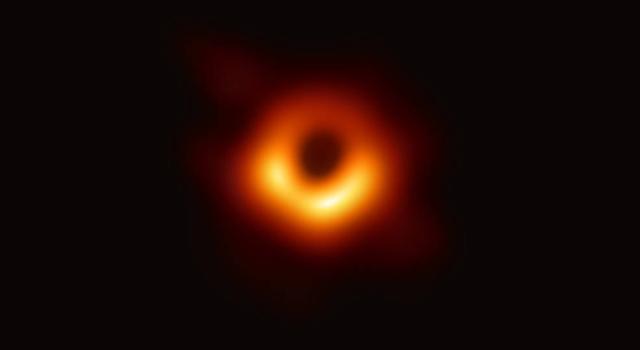
Black holes are extreme objects in the universe where all the current known laws of physics break down. Einstein's theories predict that at the heart of the black holes, time completely stops and ceases to exist.
But singularities does not only appear at the heart of the black holes. You see, if we rewind our clock back to 13.7 billion years ago, Einstein's theories predict that everything in the universe was once condensed into an unimaginably small, hot, and dense state—an infinitesimal point where the laws of physics as we know them break down. Think of the universe's existence as a film with a runtime of 13.7 billion years: if we rewind that movie continuously, Einstein's theories work all the way to the last second, but when we reach 10^(-43) seconds after the Big Bang, a time frame so minuscule that the human brain will never properly conceive, our cosmic film encounters a peculiar glitch. We encounter the exact same problem: At the very beginning of the universe, the reality, the space and time, we again encounter infinity in our equations. At this cosmic split-second, the universe's dimensions shrink to quantum scales, and Einstein's theories clash with another successful theory in science: the quantum physics. This in its own, deserve its own story— widely regarded as the biggest mystery of modern physics.

At 10^(-43) seconds after the beginning of our universe, all the current known laws of physics break down. Because of this this, there is a big gap in our understanding of how space and time began, where did it come from, and their fundamental nature.
While Einstein's groundbreaking ideas significantly enhanced our understanding of time, they also brought forth new mysteries. For instance, the concept of time travel to the future is permitted by Einstein's equations. The GPS and the astronauts in space are, technically, traveling into a minuscule but measurable journey into the future. Einstein's theories have long shifted from just a realm of theory, time travel to the far future is now only an engineering problem. We just need to figure out a way to move extremely fast, or travel into regions of universe where extreme gravity is present, among other solutions (such as wormholes, closed time-like curves, and etc. but that's for another story).

Einstein's equations permit traveling into the future. However, trying to apply them into the past leads to a number of paradoxes.
However, here's the tricky part: attempting to extend these ideas to time traveling into the past leads to paradoxes and challenges, such as the violation of causality. Causality is the fundamental principle that cause precedes effect—events happen in a sequence, and the cause occurs before the resulting effect. The stability of the fabric of reality seems threatened by the possibility of events influencing their own past occurrence. This leads to one of the biggest unsolved mysteries of physics: Why does time only moves forward? We've mentioned earlier that time is a dimension, the fourth dimension. In one-dimentional spatial dimensions, an object can move freely in two directions. However, time appears to have a unique preference—a unidirectional flow. Understanding the origin of this one-way arrow of time, in contrast to the bidirectional nature of spatial dimensions, remains a mystery to this day.

In a one-directional (1D) spatial coordinated system, you can move in both directions. However, in our universe's one-dimensional time, it seems like we can only move in one direction: forward.
To further complicate this mystery, another aspect that makes the arrow of time particularly intriguing is the fact that in the microscopic laws of physics, particularly at the level of fundamental particles, physical processes are time-reversible. For example, if you were to observe the motion of particles in a simple physical interaction, you could play the scenario backward, and it would still be a valid description of the physics involved. The equations governing the behavior of these particles do not inherently dictate a preferred direction for time. So, why then, at the macroscopic scale— the scale at which we experience the world—there is a clear and undeniable arrow of time. We remember the past but not the future, ice cubes melt into water but don't spontaneously refreeze, and we age in one direction. We are all made of the same particles that don't follow the one direction of time, yet, our experiences clearly dictates one. While Einstein's equations beautifully describe the flow of time, they don't provide a clear answer to why time has a preferred direction.
Another perplexing question arises when we consider the concept of 'before' the beginning of the universe. What happened in the prelude to our cosmic existence? Since space and time "only" began 13.7 billion years ago, what happened "before" that? Did time have a meaningful existence prior to the explosive birth of the universe, or does the very notion of "before" lose its meaning in the absence of time? In a case where "time" ceases to exist "before" the beginning of the universe, how is anything even possible to happen without the existence of a temporal dimension? If time had a beginning does that mean that in an inconceivable far future, it will "end"? If it does, how it will happen? What does even "end" mean in the absence of time?
Perhaps one day we will uncover the answers to these questions, but it's equally plausible that the universe will always hold its secrets tightly, forever concealing the truths that lie beyond our current grasp.
Until that day comes, these are the questions that how many times I try to spend my day to avoid with, will always keep haunting me back at night. Indeed, time plays a cruel riddle in the minds of those who are cursed with knowledge.